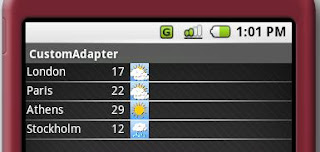Adapters are simple devices. On one side of the adapter is a data structure like a Java object storing data. SimpleAdapter handles Java objects that can be meaningfully translated into Strings by invoking the objects' toString() method (every Java object supports that but for quite many of them, the toString() format is not meaningful for the end user). On the other side of the adapter, there is a View that the data structure was transformed into. That View is displayed to the user. As we use Adapters to supports list views, the Adapter handles lists of Java objects (that are eventually transformed into a list of Views).
Android's built-in adapters are sufficiently versatile but it is often handy to create a custom adapter. Let's look at the following example.

You can download the example code from here.
The example is a simple weather display. A weather entry consists of 3 data items: name of the city (String), temperature in the city in degrees (integer) and an icon showing whether the sky is sunny, overcast or it is raining. The first two entries could be handled using SimpleAdapter but the third cannot: SimpleAdapter does not handle icons. Therefore we create our own adapter, called WeatherAdapter that takes list of Weather objects storing the weather info and turns that list into Views that can be rendered as list rows.
The most important part of the trick happens in a private class in WeatherAdapter.java called WeatherAdapterView. WeatherAdapter does nothing more than manages a list of WeatherAdapterViews. WeatherAdapterView is the View the Weather data object is mapped to. It is itself a composite View, composed by a LinearLayout. The LinearLayout is set up programmatically (as opposed to an XML layout) and contains two TextViews and one ImageView. The ImageView encapsulates the icon. It is worth checking how the icon images are referenced in Weather.java: as the icons are in the res/drawable directory, R.java has integer IDs for them. The getSkyResource() method in the Weather class just returns this resource ID based on the sky member variable of the Weather class.



 7:38 AM
7:38 AM
 sempax
sempax

 Posted in:
Posted in:
0 comments:
Post a Comment